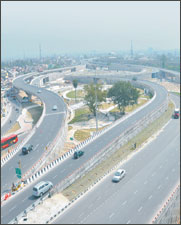Highways Ministry initiates measure to avoid delays in tendering process of EPC projects
September 18, 2013
In a bid to ensure that the tendering process of projects sanctioned for implementation in the Engineering, Procurement and Construction mode does not encounter delays, the Ministry of Road Transport and Highways has taken a decision allowing state governments to issue Request for Proposal in case of works costing less than Rs. 100 crore under the single stage two cover system, as was followed for item rate contracts based on the Standard Bidding Document.
An office memorandum issued by the MoRTH on September 6th, 2013, said that the eligibility (qualifying) criteria prescribed would have to adhere to the Request for Qualification for EPC projects.
In the single stage two cover system, bids are invited under two covers. The eligibility of the bidders is first examined on the basis of details submitted under the first cover (technical bid). The financial bid under the second cover is opened only for those bidders who qualify based on evaluation after opening of the first cover.
The MoRTH has already declared the eligibility limit of 34 conditionally qualified applicants who had sought annual pre-qualification under RFAQ 2013 (umbrella RfQ) for national highway projects to be implemented in the EPC mode. A total of 17 applicants were considered non-responsive in the process. In case of 144 applicants, certain clarifications had been sought by September 10th, 2013. The results of these applicants are expected to be declared after the clarifications have been furnished.
Applications for annual pre-qualification under RFAQ 2013 were invited in May this year. The eligibility limit (as on July 5th, 2013) declared by the MoRTH would be valid till June 30th, 2014. Those found qualified/eligible can bid for projects having estimated project cost within their pre-qualified eligibility limit. Pre-qualified applicants are entitled to make simplified applications at the RFP stage of each project.
Backward-bending policy to take toll
January 5, 2010
The B K Chaturvedi committee has suggested ways for expeditious financing and implementation of the National Highways Development Project (NHDP). It has rectified problematic rules concerning the exit policy, bid security, security to lenders, request for qualifications (RfQ) and request for proposal (RfP). These belated measures will surely make highway projects more attractive for investors.
However, some other recommendations bear unmistakable signs of fear psychosis, perhaps caused by the reduced private investment in highways during 2008-09. The decline was largely due to two reasons: the detrimental and mid-course changes made in RfQ and RfP rules, and the economic downturn. But in a typical panic-driven response, the committee has confused symptoms with the causes. Thus, it has introduced some questionable changes in the model concession agreement (MCA) for tolled projects. Conversely, several crucial issues have been ignored.
To put arguments in perspective, recall the pre-August 2008 scenario: 9%-plus growth rate, upbeat credit and financial markets, and bullish investors scrambling for projects to invest in. During 2006-07, more than 60 highway projects attracted private investment. In fact, there was a shortage of well-structured projects on offer.
The extant rules regarding the viability gap funding (VGF) and termination of contract posed no threat to the attractiveness of highway projects. Yet, the committee has targeted these rules to implement investors’ wishlist. Under a BOT-toll contract, an investor is granted the right to charge toll from users.
There are two main justifications for this concession: investors provide upfront funding for projects, alleviating the taxpayers’ burden, and bear the construction, maintenance and commercial risks. VGF grant is provided to make a socially-desirable but unprofitable project attractive for an investor. The underlying objective is not, and should not be, to add to the upfront financing — that is for the private sector to do. Limited funds are available for VGF. The MCA rules allow VGF up to 40% of the project cost; 20% during construction phase and the rest during maintenance phase.
In contrast, the committee has offered the entire grant during construction phase itself, and has reduced
it to a mere cost-sharing device. Further, compared to what would have been possible under the earlier rules, now the grant requirement of fewer projects will be met with. So, at least in the short run, fewer grant-dependent projects will take off.
Besides, an investor can borrow 20% of project cost at concessional rates from the IIFCL, a public sector company. Indeed, excluding the profit margins, an investor can meet up to 70% of cost just using grants and other funds raised by public sector entities. Simply put, what was to be the investor’s responsibility has been passed on to the taxpayer, undermining the rationale of VGF as well as toll contracts. Moreover, an investor is reimbursed 90% of due debt if the contract gets terminated. So, the new rules are likely to create moral hazards during construction phase and later.
Under MCA rules, if actual traffic turns out to be less (greater) than predictions, the concession period is increased (reduced) proportionately. If traffic increases beyond the designed capacity, to avoid congestion, the concessionaire is required to widen the road at his cost. These rules imply that road users get satisfactory service, and the investor and the taxpayer share the unanticipated losses (gains) arising from traffic-risk. In contrast, under the new rules, if the government asks for capacity expansion on account of high traffic, it will have to compensate the investor. Moreover, the contract period cannot be reduced. So, the event of traffic exceeding the designed capacity has become lucrative for the investor. It would ensure them unexpectedly high profit.
Source: economictimes







